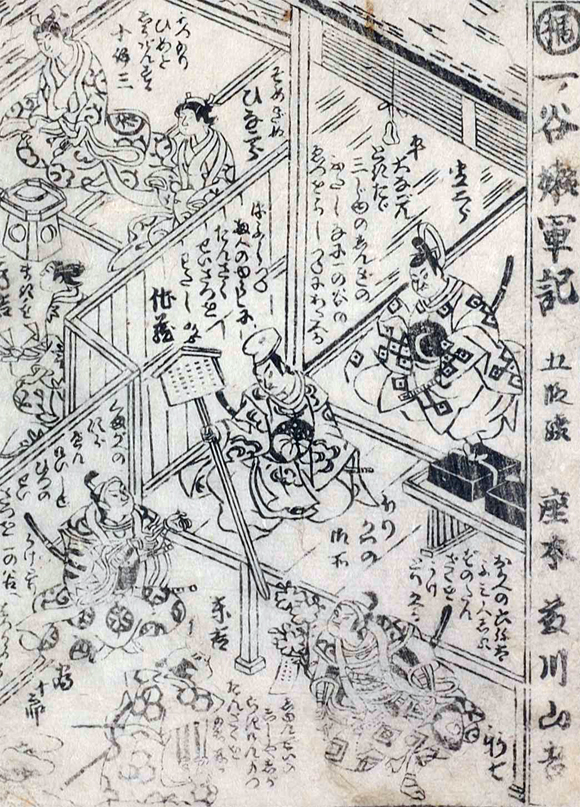| HORIKAWA GOSHO |
| Play title | Ichi-no-Tani Futaba Gunki |
| Common title | Horikawa Gosho |
| Authors | Namiki S˘suke Asada Icch˘ Namioka Geiji Namiki Sh˘z˘ I Naniwa Sanz˘ Toyotake Jinroku |
| History |
The play "Ichi-no-Tani Futaba Gunki" (five acts) was originally written for the puppet theater and staged for the first time in ďsaka at the Toyotakeza in the 12th lunar month of 1751. It was adapted for Kabuki the following year and staged for the first time in Edo at the Moritaza in the 4th lunar month of 1752 [casting]. It was also performed for the first time in ďsaka in the 11th lunar month of 1752 at the Naka no Shibai as a kaomise drama [casting]. "Horikawa Gosho" ("at the Palace in Horikawa") was revived only once after WW2, in March 2012 at the National Theatre. The previous staging of "Horikawa Gosho" was in December 1914 at the Miyatoza. |
| Structure |
The "Horikawa Gosho" scene ("at the Palace in Horikawa"), which is rarely staged, is the first scene of the first act (daijo) of "Ichi-no-Tani Futaba Gunki". |
| Key words |
Daijo Genji Genpei Kassen Genpei-kassenmono Gidayű Ky˘gen Giri/Ninj˘ Heike Horikawa Horikawa Gosho Ichi-no-Tani Ichi-no-Tani no Tatakai Jidaimono Kumagai Naozane Ky˘-no-Kimi Minamoto Yoritomo Minamoto Yoshitsune Okabe Rokuyata Okabe Tadasumi Taira Atsumori Taira Tadanori Taira Tokitada |
| Summary |
Kur˘ Hangan Yoshitsune, younger brother of Minamoto Yoritomo, the powerful head of the Genji clan, who has been asked by brother to lead the Genji armies in a crucial battle against the Heike clan, is mapping out a strategy with his high-ranking retainers at his Horikawa Palace in Ky˘to. Taira no Tokitada, the father of Yoshitsunes wife Ky˘-no-Kimi, who is on the Genji side in spite of the fact that he belongs to the Heike clan, visits his son-in-law to present to him two of the three sacred treasures of the Imperial Household. There is a mirror and a necklace made of precious stones, which he has stolen from Heike's hands. He tells Yoshitsune that he has failed to secure the third treasure, a sword, because it is personally carried by the young emperor Antoku. Tokitada also gives Yoshitsune a map showing the locations of Heike troops, which are preparing to fight off the coming Genji's offensive. Kiku-no-Mae, daughter of the court noble Fujiwara no Shunzei, brings to Yoshitsune a strip of paper bearing a poem written by Taira no Tadanori, an important warrior of the Heike clan and a famous poet, to ask Yoshitsune's opinion about her father's plan to include the poem in the "Senzai Wakashű", a collection of poems which her father is compiling as an Imperial command. Tokitada opposes the inclusion on the ground that Tadanori is an enemy of the Imperial Household. Tokitada and Kiku-no-Mae begin quarrelling. Yoshitsune intervenes and persuades them to leave the matter to his discretion. After Kiku-no-Mae has gone, Yoshitsune is visited by two warriors, Okabe Rokuyata Tadasumi and Kumagai Jir˘ Naozane. Okabe delivers to Yoshitsune Yoritomo's letter urging him to begin his attack on the Heike force as soon as possible. Kumagai tells Yoshitsune that it is advisable to go to the battlefront immediately, for some retainers of Yoritomo told their lord that Yoshitsune is so attracted by his pretty wife Ky˘-no-Kimi that he is hesitant to lead the planned offensive against the Heike. Yoshitsune laughs at the false accusation and expresses his confidence in defeating the enemy, for he has not only carefully worked out his strategy but also obtained a map showing the locations of the enemy units. He then ties the strip of paper bearing Tadanori's poem to a severed twig of a cherry tree and tells Okabe to carry it to the house of Tadanori and inform him of Yoshitsune's decision to include his poem in Shunzei's collection as a work of an anonymous poet. Yoshitsune then delivers to Kumagai a wooden notice board bearing a warning that anyone who has broken a twig of a cherry tree shall have his finger cut off. The warning represents Yoshitsune's cleverly-camouflaged order to Kumagai not to kill Taira no Atsumori, a young Heike warrior who is actually the son of the previous emperor. In Japanese language, the words 'twig', 'finger' and 'child' are phonetically the same. |
 |
||
|
Illustration from the ezukushi banzuke for the "Hirakawa Gosho" scene of the drama "Ichi-no-Tani Futaba Gunki", which was staged in the 3rd lunar month of 1782 at the Kado no Shibai with Nakayama Taz˘, Asao Tamejűr˘ I and Onoe Shinshichi I in the roles of Minamoto no Yoshitsune, Kumagai Jir˘ Naozane and Okabe Rokuyata Tadazumi |
||
|
|
| Contact | Main | Top | Updates | Actors | Plays | Playwrights | Programs | Links | FAQ | Glossary | Chronology | Illustrations | Prints | Characters | Derivatives | Theaters | Coming soon | News |